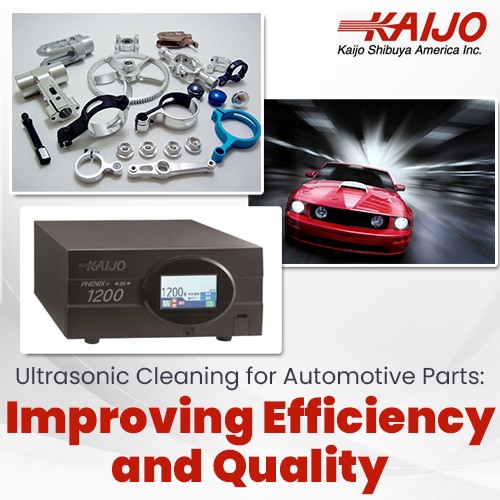Ultrasonic Cleaning for Automotive Parts: Improving Efficiency and Quality
June 6, 2023
 With the right ultrasonic cleaner, contamination can be removed from all types of automotive parts. The ultrasonic systems work more quickly than traditional methods and deliver completely clean parts, even for difficult cleaning applications. The manufacturing, repair, and restoration processes become more efficient, increasing output quality. Switching to ultrasonic cleaning reduces costs and improves overall shop performance.
With the right ultrasonic cleaner, contamination can be removed from all types of automotive parts. The ultrasonic systems work more quickly than traditional methods and deliver completely clean parts, even for difficult cleaning applications. The manufacturing, repair, and restoration processes become more efficient, increasing output quality. Switching to ultrasonic cleaning reduces costs and improves overall shop performance.
How Ultrasonic Technology Cleans Automotive Parts
Ultrasonic cleaning technology is flexible enough to meet many different cleaning requirements. Because automotive parts are so varied, ultrasonic cleaning systems are an excellent solution for all automotive part cleaning needs.
Ultrasonic cleaners work by generating microscopic cavitation bubbles in the cleaning solution. Ultrasonic generators feed high-frequency signals to transducers located in the ultrasonic cleaning tanks. The transducers convert the electric signals into sound waves. When the sound waves travel through the cleaning solution, they produce the bubbles responsible for the scrubbing and cleaning action.
The ultrasonic cleaning systems can be configured for different automotive cleaning tasks. A low frequency produces comparatively large bubbles for intense cleaning, and higher frequencies produce smaller bubbles and gentler cleaning for light contamination of delicate parts. Configured correctly, ultrasonic cleaners can meet different automotive cleaning needs.
How Ultrasonic Cleaning Benefits Manufacturers, Repair and Restoration Shops
Automotive ultrasonic cleaners can reduce costs, increase operating efficiency and improve output quality. Cost savings result from reduced use of expensive cleaning chemicals. The ultrasonic cleaners work more quickly than traditional cleaning methods, and automotive parts with complex geometries are cleaned completely. The cavitation bubbles are generated throughout the cleaning solution, so contaminants are removed from internal cavities, dead-end holes, and nozzles. Parts manufacturers and repair and restoration shops benefit from cleaner parts with reduced cleaning times and lower operating costs.
How Different Automotive Parts Are Cleaned with Ultrasonics
The selection of an automotive ultrasonic cleaner depends on the type of contamination and the nature of the part to be cleaned. Specific automotive parts include the following:
- Cylinder Heads – one of the lowest ultrasonic frequencies of 26 kHz can quickly remove carbon deposits.
- Brake parts – greasy deposits can be removed with 26 kHz, and the ultrasonic cleaning tanks can be heated for faster cleaning.
- Casings and Gears – the 26 kHz cleaning frequency will remove oil and grease from these robust parts. For heavy contamination, a mild detergent can be added to the cleaning solution, which can be heated to speed up cleaning.
- Carburetor Parts – parts may be fragile and contamination light. A higher frequency of 38 kHz may be appropriate.
- Coated and Plated Parts – surfaces may be cleaned with higher frequencies to avoid pitting. An ultrasonic cleaning system operating at several frequencies allows testing to determine the best solution.
- Electronics and sensors – electronics may be fragile, and sensors can have delicate surfaces. Cleaning at 100 kHz or higher can ensure safe cleaning.
How to Choose the Right Ultrasonic Cleaning System
When the right ultrasonic cleaner is used for the application, cleaning performance generally exceeds that of traditional methods. In addition to the right frequency, the cleaner has to have enough power to fill the tank with sound waves. There must be enough ultrasonic transducers, and the tank may need a heater for some applications.
For varied automotive part cleaning, the tank has to be big enough to fit the largest part. A basket may be needed if many small parts are to be cleaned. Transducers can be permanently installed, or they can be independent units placed into cleaning tanks as needed. An experienced manufacturer of automotive ultrasonic cleaning systems can help configure the cleaning system.
How Advances in Ultrasonic Cleaning Technology Can Help Improve Efficiency and Quality
While the basics of ultrasonic cleaning technology are well-known, advances in cleaning effectiveness and efficiency will make ultrasonic cleaning even more attractive. Improving the cleaning action of the cavitation bubbles and integrating automation and robotics for more efficient material handling can save time. For the automotive industry, increased regulations for using and disposing of oil, grease, and chemicals will impact operations and encourage a switch to ultrasonic cleaning.
Kaijo Expertise and Guidance
Kaijo has long been a world leader in developing advanced ultrasonic cleaning technology for automotive and other industries. Since Kaijo designs and builds its own ultrasonic systems, they are ideally situated to guide customers in the automotive industry who would benefit from ultrasonic technology. Kaijo offers free consultations to help customers make informed choices to ensure they use the best ultrasonic system for their application.





